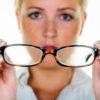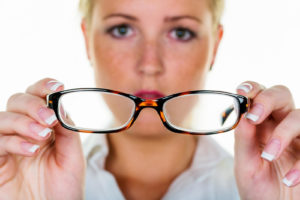
What Are Refractive Errors? A Comprehensive Guide
Refractive errors are possibly the most common eye conditions among children and adults alike. It isn’t all that unlikely that some people suffer from more than one refractive error at the same time.
Doctors usually use glasses to fix refractive errors. Often, doctors prescribe glasses without much explanation. If they’ll fix your eyesight, why ask questions?
Here’s the kicker: all refractive errors can be improved through proper diet and vision therapy. However, before we can get into that, we need to understand refractive errors and what they are. Welcome to your comprehensive guide to all refractive errors.
Myopia
Myopia, more commonly known as nearsightedness, is the most common refractive error. When a person is nearsighted, objects close to the eye will appear clear, but when looking at objects in the distance, they will be blurry.
This refractive error is often caused by abnormalities in the lens of the eye, the cornea, and the length of the eyeball. Typically the eyeball will be too long; the lens, too thick; and the cornea too curved. Though myopia can be caused by any one of these conditions, it is often due to a mix of the three.
When someone has myopia, they’ll likely have no trouble reading this article without glasses; however, seeing something on a TV screen will prove difficult. Doctors specialize in eyeglasses for each individual eye to help reflect light properly.
When someone is nearsighted, it means that the light entering the eye is not reflecting properly onto the retina. Rather than being reflected right onto the surface of the retina, it is being reflected in front of the retina.
Who’s at Risk?
Myopia typically affects children. During a child’s eye development, it can happen that the eye grows abnormally, causing myopia. However, many children grow out of this as the eyeball grows to fit the lens and cornea.
That being said, it isn’t always the case. When childhood myopia is caused by the cornea or the lens, a kid won’t necessarily grow out of it. Unless corrected, their poor vision will follow them into adulthood.
Hyperopia
Hyperopia, otherwise known as farsightedness, is myopia’s cousin error. When someone is farsighted, it means that objects in the distance appear clear, while objects close to the eye are difficult to see.
However, hyperopia can affect individuals in vastly different ways. While some will experience drastic differences in sight when looking at objects in the distance versus objects near, others will hardly see a difference. This leads to many people not knowing that they are farsighted.
Some people with hyperopia may also have overall blurred vision, meaning that distant and near objects are blurred but they may be slightly less blurred at a distance. It can be difficult to tell on your own if you have hyperopia because it isn’t always obvious. If you suspect you may have a refractive error, have your doctor diagnose you.
Exceptionally short eyeballs cause hyperopia. As a result, light refracts behind the retina as opposed to in front of the retina (myopia) or directly on the retina (regular vision).
Who’s at Risk?
While this condition can affect children and adults, those most at risk are people with parents with hyperopia. Genetics don’t always cause hyperopia, but the chances of a child being born with the condition are heightened when one or both of the parents have hyperopia.
Hyperopia is the result of the cornea and the lens being misshapen, however, a shortened eyeball is not always to blame. An eye injury can also cause the eye to become misshapen permanently and leave a previously unaffected eye with a refractive error.
Astigmatism
Astigmatism is a refractive error that refers to the irregular curvature of the cornea. Often astigmatism is present along with myopia or hyperopia, but it can also be a refractive error on its own.
The main difference between astigmatism, myopia, and hyperopia is that astigmatism is not caused by the size of the eyeball. Most people with astigmatism are born with a typically sized eyeball, but an irregular cornea.
That irregularity can present itself in various forms. A cornea that is curved too much or too little causes astigmatism. Abnormal curving is not always the culprit. Sometimes the cornea can have bumps, which will also cause astigmatism.
When light refracts through an irregular cornea, the light on the retina is unfocused, causing blurred vision all around. Near and distant objects will appear blurry.
Who’s at Risk?
It is hard to really pinpoint who is at risk of having astigmatism. In most cases, people are born with astigmatism to parents who don’t necessarily have the condition. Researchers don’t know what causes the cornea to grow irregularly.
Astigmatism can also be caused by an eye disease that alters the shape of the cornea or an eye injury.
Presbyopia
We have come now to our final refractive error: presbyopia. Unlike the previously mentioned refractive errors, presbyopia is one that will affect everyone as we get older.
Here’s where things get a little tricky. Presbyopia is technically a type of hyperopia because distant objects will appear clear while near objects will not. However, presbyopia is caused when the lens begins to lose its elasticity.
Though there are ways to put off developing presbyopia by keeping your eyes strong, the lens will eventually tire. This is a normal part of aging. Typically the lens begins to lose its elasticity around the age of 40, but can begin as early as 35 if you don’t take proper care of your eyes.
Who’s at Risk?
Everyone! But that doesn’t mean that you have to submit to this condition. Strengthening your eyes through diet and exercises and seeing your eye doctor once a year can keep your eyes stronger for longer.
Vision Therapy for Refractive Errors

Most of the time, physicians correct refractive errors using eyeglasses. That’s a fine solution if you’re looking for a temporary fix. However, for those looking to improve their vision naturally and for those looking to say a permanent goodbye to eyeglasses, vision therapy could be a good option.
Vision therapy is an individualized type of therapy that consists of regular vision therapy sessions coupled with at-home eye exercises. Doctors tailor vision therapy to fit your specific needs, making it a great option to fix refractive errors. You know you won’t receive some generalized regimen.
Refractive errors can be a thorn in our side as we live day to day. However, vision therapy can help to improve your sight and your eye strength for healthy eyes.
Our Rebuild Your Vision Ocu-Plus Formula Contains All 17 Vitamins, Minerals, and Herbal Supplements to Improve Your Eye Health!












thanks for the sensitization. I need more explanations and how do I get the drugs and the medicated eyeglass, and its cost implication?
How does one find vision therapy?
I am in Durham/Chapel HIll, nc area
I have a droopy eye lid ,Some days worse then others ,is there a exercise for this problem? Or a diet !
I’m suffering from myopia… From last 2 years… Plzz send me to any solution to correct my vision Naturally and physically.. I don’t want to wear glass on my eyes